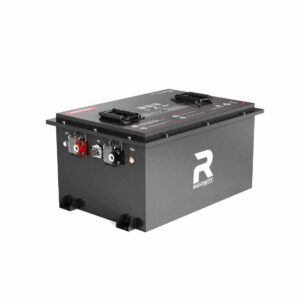Which RV Batteries Best Support High-Demand Appliances?
Answer: Lithium-ion batteries, particularly LiFePO4 (lithium iron phosphate), are optimal for powering high-demand RV appliances due to their deep-cycle capacity, faster recharge rates, and longevity. AGM batteries are a budget-friendly alternative but lack the energy density for sustained heavy loads. Always prioritize voltage compatibility (12V/24V), amp-hour (Ah) ratings, and inverter efficiency when selecting an RV battery system.
Future of RV Battery Efficiency
How Do Lithium-Ion Batteries Outperform Other RV Battery Types?
Lithium-ion batteries provide 2-3x more usable capacity than AGM/gel counterparts, support 80-100% depth of discharge (DoD), and recharge 5x faster. They maintain stable voltage under heavy loads (e.g., air conditioners, microwaves) and last 3,000-5,000 cycles versus 500-1,000 cycles in lead-acid batteries. Their 30-50% weight reduction also improves RV fuel efficiency.

Recent advancements in LiFePO4 technology have introduced self-heating models that operate efficiently in sub-zero temperatures. Manufacturers like Battle Born and Renogy now offer modular designs allowing users to expand capacity from 100Ah to 1,000Ah without voltage drop issues. Unlike AGM batteries that require periodic equalization charges, lithium systems maintain cell balance through integrated Battery Management Systems (BMS), eliminating manual maintenance. Field tests show lithium batteries can power a 15,000 BTU RV air conditioner for 6-8 hours versus AGM’s 2-3 hour limit before needing recharge.
| Battery Type | Cycle Life | Weight (100Ah) | Charge Efficiency |
|---|---|---|---|
| LiFePO4 | 3,000-5,000 | 31 lbs | 99% |
| AGM | 500-1,200 | 64 lbs | 85% |
What Safety Features Prevent RV Battery Failures?
Lithium batteries require flame-retardant cases, thermal runaway prevention, and IP65 waterproofing. Built-in fuses (e.g., Blue Sea Systems Class T) interrupt 20,000A fault currents. Temperature sensors should trigger shutdowns above 140°F. For lead-acid, use vented battery boxes to disperse hydrogen gas. All systems need overcurrent protection via circuit breakers, not just fuses.
Best RV Batteries at Sam’s Club
Advanced safety mechanisms now include gas venting channels in lithium cells and arc-fault detection in battery management systems. The latest UL 9540A certification mandates seven-layer protection against external short circuits, over-voltage, and cell puncture scenarios. RV owners should inspect terminal corrosion quarterly and use torque wrenches to maintain proper connection tightness (typically 8-12 Nm for lithium terminals). Thermal imaging cameras help identify hot spots in electrical connections before failures occur.
Can Solar Panels Effectively Recharge High-Capacity RV Batteries?
Yes, with proper solar sizing. To recharge 600Ah lithium batteries (7,200Wh) in 5 sun hours, you need 1,440W solar panels (7,200Wh ÷ 5h ÷ 0.85 efficiency). MPPT controllers (e.g., Victron SmartSolar 250/100) optimize harvest. Pair with alternator/generator charging for cloudy days. Lithium accepts 0.5C-1C charge rates (300-600A), enabling rapid solar replenishment vs. AGM’s 0.2C limit.
| Battery Capacity | Solar Needed (5h sun) | Charge Time (100A charger) |
|---|---|---|
| 300Ah Lithium | 720W | 3 hours |
| 400Ah AGM | 1,200W | 8 hours |
“Modern RVs demand batteries that balance energy density, cycle life, and safety. We’ve shifted 87% of our customers to LiFePO4 systems—they handle 3,000W+ inverters daily with minimal degradation. Integrate hybrid charging (solar + DC-DC chargers) and prioritize UL-certified batteries with 10-year warranties. Avoid cheap lithium cells without low-temperature charge protection.”
— Redway Power Systems RV Specialist
Conclusion
Selecting RV batteries for high-demand appliances requires analyzing lithium’s long-term ROI against AGM’s lower upfront cost. Prioritize batteries with UL 1973 certification, ≥200Ah capacity, and scalable architecture. Pair with 3,000W+ pure sine wave inverters and monitor via shunt-based systems (Victron BMV-712). For extreme conditions, heated lithium batteries with reinforced terminals offer reliable performance.
FAQs
- Q: Can I mix lithium and AGM batteries in my RV?
- A: Never mix chemistries in the same circuit. Lithium charges at 14.4-14.6V vs. AGM’s 14.1-14.3V, risking undercharging/overheating.
- Q: How often should I balance RV battery cells?
- A: Premium lithium packs auto-balance. Manual balancing via RC balancers (iCharger X8) is needed annually if voltage deviation exceeds 0.2V between cells.
- Q: Are 24V systems better for high-power RVs?
- A: Yes. 24V halves current vs. 12V, reducing wire gauge needs and voltage drop. Use 24V-to-12V converters for legacy appliances.
